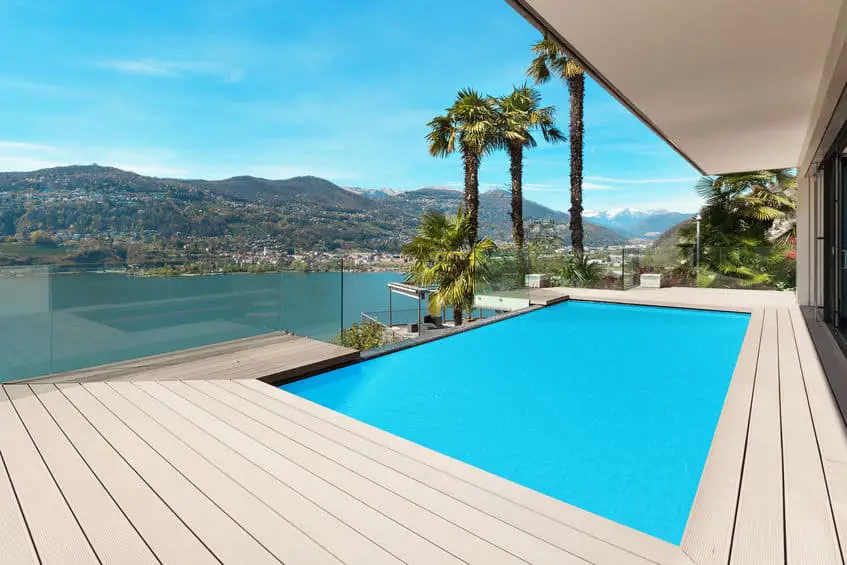This post contains affiliate links.
One of the major issues regarding any type of decking is that they could get really slippery especially when they get wet or during winter when it snows. Some decks can be slippery even when they’re not wet. With the advent of composite decking, being hailed by some as a better alternative to wood decking, has it addressed the issue of deckings being slippery?
Is composite decking anti-slip? There are some composite decking products that are designed to reduce slipping. However, there’s still no 100% anti-slip composite decking. Most of them though perform better than conventional wood decking in terms of slip resistance. And there are things you can do to increase the surface traction.
Composite decking, regardless of the anti-slip treatment done, could become slippery at some point. Some can become slippery easily than others, and different conditions could influence this from happening. It is then important to understand how composite decking becomes slippery and how to prevent it from happening.
What can Make a Composite Decking Slippery?
The most common reason why composite decking becomes slippery is different dirt and organic particulates that accumulate on the surface. These are algae or fungal growth, molds, or mildew, which can make the surface slippery.
In wood decking, the absorption of water and becoming moist makes it a perfect host for fungal growth. This in turn will make the wood decking slippery. Composite decking on the other hand has a very low water absorption rate which will prevent fungal growth. But then, when dead leaves, pollen, dirt, and dust, accumulates on the composite decking’s surface, it could encourage molds and mildew to grow on the surface.
During winter, when composite decking becomes wet, water can get into the crevices and grooves of the surface which hardens into ice. And this can lead to the decking becoming slippery. Uneven surfaces caused by bad installation work can collect water at some portions of the decking which can harden into a big chunk of ice.
With regards to water, although most composite decking has a very low water absorption rate, it is best to check the product and get the one with the least water absorption rate. Older models of composite decking have a higher water absorption rate, which is not ideal for areas that get exposed to moisture often.
Some chemicals, lubricating liquids, oil, and grease spills, of course, can also make the composite decking surface slippery. So as much as possible, try not to expose your composite decking to these types of liquids.
What Can You Do to Increase the Traction of Composite Deckings?
When choosing a composite decking that is less slippery, you should always look for a specific model that has an anti-slip property. If you already have composite decking installed and you don’t plan on changing it anytime soon, there are a number of ways to increase its surface traction.
Below are 4 ways to make your composite decking less slippery.
1. Make it a habit to clean the surface regularly.
This does not only apply with composite decking but also for other outdoor surfaces as well. Although composite decking does not absorb water, dirt, dust, dry leaves, and other particulates can accumulate on the surface which can encourage fungal, or mold growth, causing the surface to become slippery.
Simple soap and water will do. Use a soft-bristled brush. Also, avoid using harsh chemicals that can damage the surface of the decking.
2. Install Anti-Slip Inserts or Strips
Different types of anti-slip strips are available commercially that you can install over your portions of your composite decking. They have a very rough texture that would greatly increase the surface traction of your composite decking.
There are also anti-slip inserts that can easily be installed in between the grooves of the composite decking. They are less visible than anti-slip strips and become almost part of the decking but they also increase the traction of the surface and are much safer to walk on.
3. Keep Composite Decking Dry Especially During Winter
We all know that ice is dangerously slippery to walk which is why it is essential to keep it dry during winter. Spilled drink or water will easily turn into ice over the surface.
4. Use Anti-Slip Rugs or mats
There are also anti-slip rugs or mats you can buy and place over a bigger surface of your composite decking. This, of course, wouldn’t be visually appealing but it would do its job of keeping the floor safe to walk on. You can probably do this on areas that constantly get wet, and has a tendency to get very slippery, such as near the edges of the pool.
Why Composite Decking is Better than Wood Decking for Slip Resistance?
Wood decking and composite decking have always been compared with each other in terms of performance, looks, maintenance, and others. There are of course traits of one that are better than the other. But in terms of slip resistance, in my opinion, composite decking would be a better choice.
Composite decking on its own has better slip resistance than wood decking. Although there are several measures you can take to increase traction on wood decking, there are also several things that could go wrong and make it dangerously slippery.
Wood is naturally absorbent, and wet wood can encourage fungal and mold growth which can then lead it to become slippery. Wet wood can also harden to the ice during winter which makes it dangerous to walk on.
Composite decking on the other hand has a low water absorption rate. Most of which comes with a capstock coating or capping material around the surface, made of vinyl, that repels liquid better. Since it does not absorb as much water like wood, it is less likely for it to get algae, fungal or mold growth. It also dries quickly after a period of rain.
Wood, though can be oiled and applied with a weather protection coating, it has to be reapplied every now and then to continuously seal it against moisture. This maintenance work can easily be forgotten or forego by homeowners because of the tedious task involved.
Composite decking does not need to be reapplied with any sealing product. This makes the maintenance work easier and less complicated and the worry of forgetting to reseal or to recoat as in wood is no longer there.
Composite decking is then perfect to use near wet areas such as in pools.
What to Look For When Buying a Slip Resistant Composite Decking?
If slip resistance is a priority for your decking, you should know what to look for when buying composite decking.
Not all composite decking is made non-slip and companies usually have a specific model that is specially designed to be used on wet areas and are non-slip.
So the first thing you need to do as you’re talking to a salesperson is to explicitly ask for their specific models of composite decking that are especially non-slip. He would then point you to better options for non-slip deckings.
Choose a capped composite decking. A composite decking that is capped or with capstock is impermeable to water and has a very low water absorption rate. This will ensure that it does not encourage fungal or mold growth.
Choose composite deckings that have grooved or rough-textured surfaces as this improves grip and is less likely to be slippery.
Some composite deckings can also come in with built-in anti-slip strips that are installed in between their grooves.
Also check the technical specifications, specifically the slip resistance value. Most non-slip composite decking products would have been tested in the laboratory using the pendulum slip resistance test. A value of 35 or higher is good but if you can, go for those with values of 55 and higher. At these values, you’ll know that you have good non-slip composite decking.
Once you have chosen and installed the composite decking that seems alright, just do the minimum maintenance to keep it non-slip. Wash it with soap and water from time to time to scrub the surface off of dead leaves, dirt, and debris.
All About Materials is a participant in the Amazon Services LLC Associates Program, an affiliate advertising program designed to provide a means for sites to earn advertising fees by advertising and linking to Amazon.com. We also participate in other affiliate programs which compensate us for referring traffic.

